A large double asteroid passed Earth this weekend (May 25, 2019) at the very safe distance of about 13.5 times the Earth-moon distance. It wasn’t visible to the eye, but it was long expected, and – as the video above shows – some observers caught it on film. This video – from Samford Valley Observatory in Australia – was made with images captured with a 14″ telescope around the time of 1999 KW4’s closest approach to Earth. It shows the space rock gliding in front of the stars. In addition, radar observations of asteroid 1999 KW4 are scheduled from Arecibo Observatory in Puerto Rico from May 29 to June 7, and from NASA’s Goldstone Solar System Radar in the desert near Barstow, California, from May 26 to 31. The radar images should show the asteroid’s dual nature; we’ll add them to this post as we see them. In the meantime, the opportunity for amateur astronomers with telescopes to observe this asteroid still exists; look for charts for telescope users below.
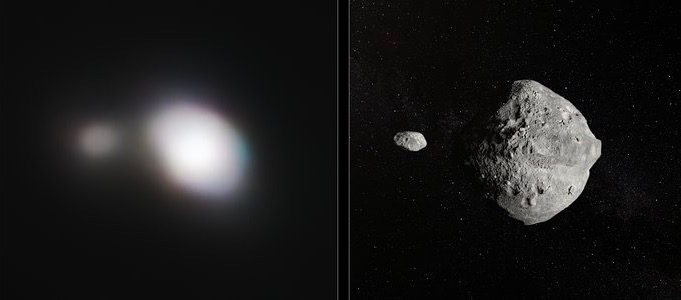
1999 KW4 is moving fast. It’s traveling at 48,123 miles per hour (77,446 km/h or 21.5 km/second), relative to Earth. Its fast speed, and the size of this asteroid, are what allow amateur observers to see it move in front of the stars. Sky enthusiasts equipped with telescopes eight inches in diameter and bigger might be able to catch this asteroid. One of the best techniques for locating it will be to point a computerized telescope to a star known to be in the space rock’s path, and wait for the asteroid to appear. It will look like a very slow moving “star.” At first, the asteroid might be tricky to detect since its motion will appear very slow. If you are pointing at the correct time and location in the sky, take a good look at the visual field of the telescope. Be patient. Good things come to those who wait.
Another idea is to draw a sketch of the positions of the brightest stars and a few other stars you see at the eyepiece. Then compare the positions just 10 minutes later, and yes, you will find the asteroid!
By updating your sketches showing the asteroid’s position with respect to the stars, you can also show the huge space rock to other people, so they can see the object that’s making news with their own eyes.
The location of asteroid 1999 KW4 during closest approach was most favorable for observers in Earth’s Southern Hemisphere. Now the space rock is drifting to other constellations, and observers in the Northern Hemisphere should be able to locate it beginning around May 27, 2019, when the asteroid will come over our southern horizon. See charts below.
Go to In-the-Sky.org for more observing information on 1999 KW4
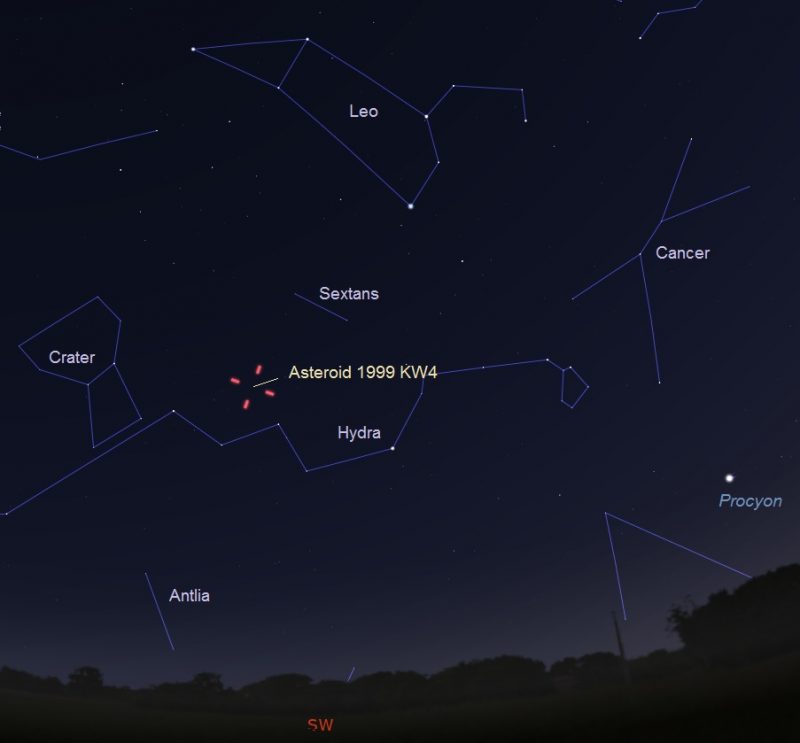
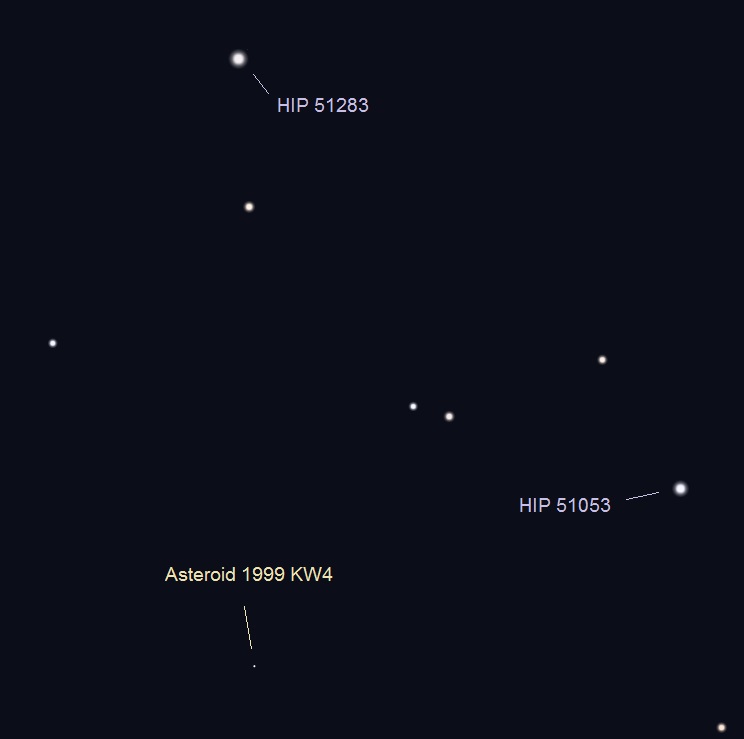
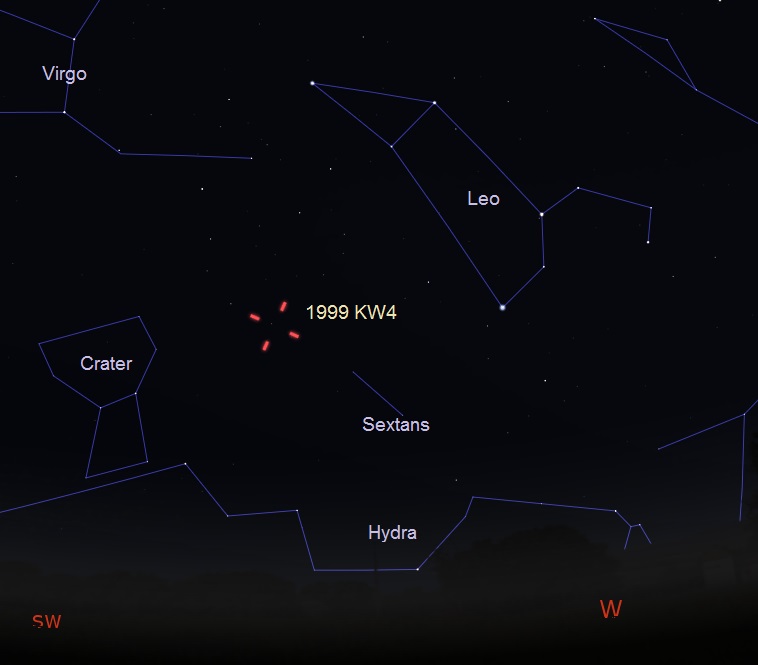
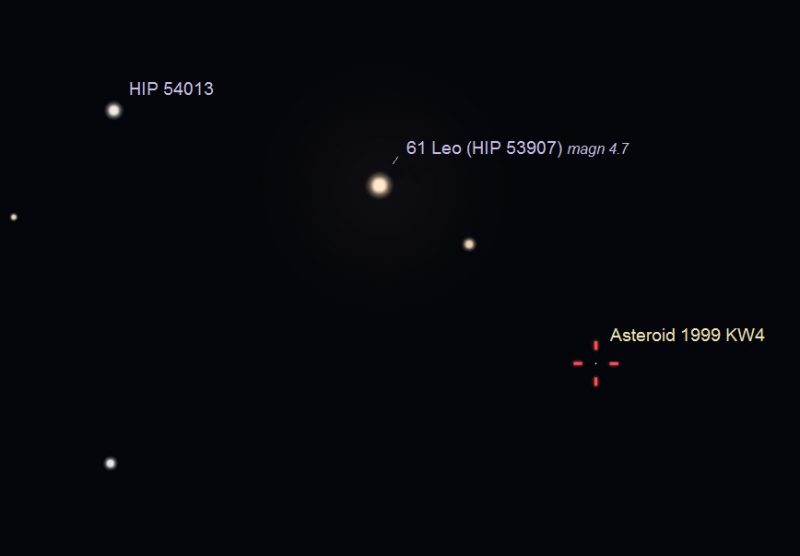
Asteroid (66391) 1999 KW4 consists of a primary space rock just under a mile wide (about 1.5 km), with a 0.3-mile-wide (0.5-km-wide) companion asteroid – an asteroid moon – orbiting the main asteroid. It’s an Aten type – or Earth-crossing – space rock. Its orbit brings it between the orbits of Venus and Earth. It completes an orbit around the sun once every 6.18 months (188 days).
An interesting facet of asteroid 1999 KW4 is its shape. It has an oblate shape with an equatorial ridge, similar to asteroids Bennu and Ryugu. Observations suggest the secondary asteroid, or asteroid moon, of 1999 KW4 orbits the main space rock every 16 hours at a distance of about 1.6 miles (2.6 km).
The video below – from a NASA Goldstone Radar planning document – shows the orbital motion of 1999 KW4 from December 2017 until July 2019, in a heliocentric or sun-centered reference frame. The asteroid makes two close flybys of Earth during this period.
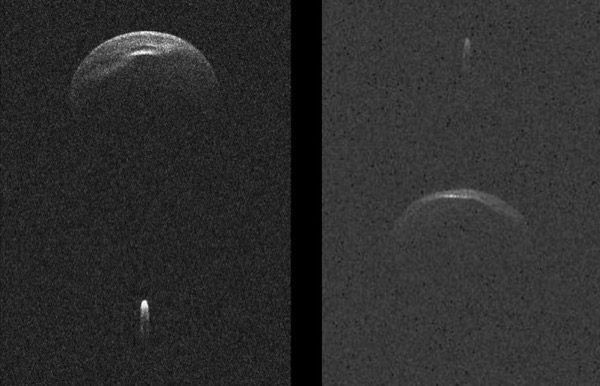
1999 KW4 was discovered by the Lincoln Near-Earth Asteroid Research (LINEAR) astronomical survey in Socorro, New Mexico, in 1999. It has been classified as a Near-Earth object and a potentially hazardous object by the Minor Planet Center. However, the orbit of this huge space rock is well understood and known to pose no risk to Earth. During the closest of its approaches to Earth, its orbit brings it no closer than five Earth-moon distances.
The next encounter with Earth, which will be even closer than this year’s, occurs on May 25, 2036.
An interesting fact: After asteroid 1999 KW4 passes by Earth on May 25, 2019, no known asteroid as big or larger than this space rock will approach our planet this close until year 2027. On June 6, 2027, asteroid 4953 (1990 MU), a 4 km to 9 km (2.5 to 5.5 mi) space rock will safety pass by Earth at 12 lunar distances, and will return on 2058 at nine lunar distances.
Take a look at the curious shape of asteroid 1999 KW4 and its moon in this video:
Bottom line: Professional and amateur astronomers geared up to observe asteroid 1999 KW4 – a mile-wide, oddly shaped asteroid with a companion moon – around its closest approach on May 25, 2019. Now observers in the Northern Hemisphere should be able to locate it beginning around May 27, 2019, when the asteroid will come over our southern horizon.











